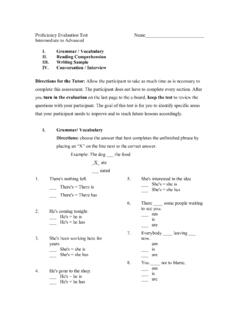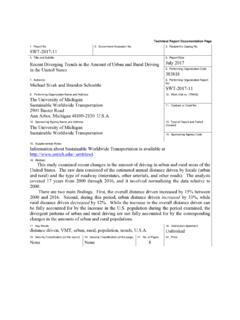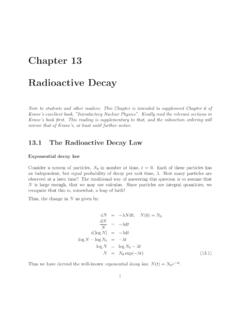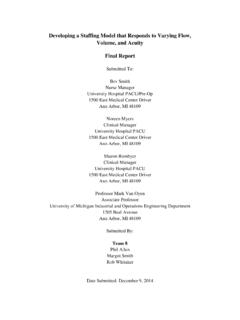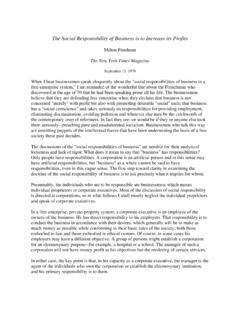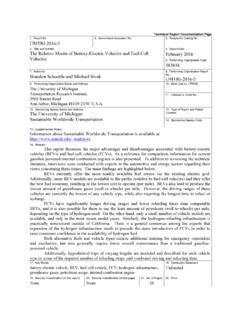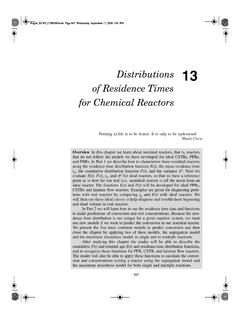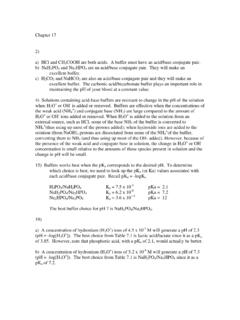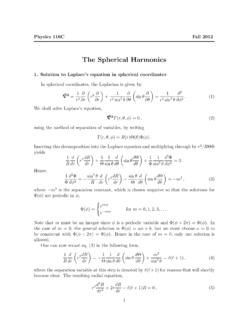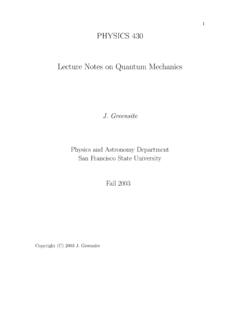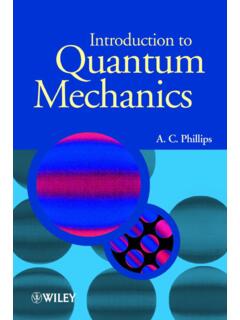Transcription of 7. The Hydrogen Atom in Wave Mechanics
1 7. The Hydrogen Atom in Wave MechanicsIn this chapter we shall discuss : The Schr odinger equation in spherical coordinates spherical harmonics Radial probability densities The Hydrogen atom wavefunctions Angular momentum Intrinsic spin, Zeeman effect, Stern-Gerlach experiment Energy levels and spectroscopic notation, fine structureElements of Nuclear Engineering and Radiological SciencesINERS 311: Slide #1 The Schr odinger equation in spherical coordinates ..In 3D Cartesian(x, y, z)coordinates, the time-independent Schr odinger equationfor asingle particle bound by a potential,V(~x), is: ~22m 2u(~x) +V(~x)u(~x) =Eu(~x),( )where 2= 2 x2+ 2 y2+ 2 z2.( )If the potential specialized toV(~x) =V(r), whereris the distance to the origin, then,it is natural to use the spherical -polar coordinate system(r, , ).Elements of Nuclear Engineering and Radiological SciencesINERS 311: Slide # The Schr odinger equation in spherical coordinates.
2 Where:ris the distance from origin to the particle location is the polar coordinate is the azimuthal coordinateConnection between Cartesian and spherical -polar:x rsin cos , y rsin sin , z rcos ( )WithdV= d~x= dxdydz=r2drsin d d , (volume element in both systems) dx dy dz f(x, y, z) 2 0d 0sin d 0r2dr f(r, , )( )The Laplacian operator of ( ) becomes, in spherical -polar coordinates: 2=R L2r2,where( )R= 2 r2+2r r,and( )L2=1sin (sin )+1sin2 2 2( )Elements of Nuclear Engineering and Radiological SciencesINERS 311: Slide # The Schr odinger equation in spherical coordinates ..SinceV(~x) =V(r), a separation of variables occurs, and the most general solution of( ) in spherical -polar coordinates is given by:unlml(r, , ) =Rnl(r)Yl,ml( , ),( )whereRRnl(r) =( 2 r2+2r r)Rnl(r) =EnlRnl(r)( )andL2Yl,ml( , ) =[1sin (sin )+1sin2 2 2]Yl,ml( , ) =l(l+ 1)Yl,ml( , )( )The radial equation, ( ) determines the energy of the system, sinceV(r)only involvesthe radial coordinate.
3 The radial wavefunctions and the quantized energies are obtainedby solving ( ). Note that the radial eigenfunctions functions and energies may dependon two quantum numbers,nandl. We shall see several examples in due angular equation, ( ), is a generic solution that applies for all the potentials of theform,V(~x) =V(r). TheYl,ml( , ) s are the eigenfunctions of the angular part of theLaplacian operator,L, withl(l+ 1)being its of Nuclear Engineering and Radiological SciencesINERS 311: Slide # The Schr odinger equation in spherical coordinatesWe have 3 quantum numbers:namerange of valuesnprincipalcan be anything, depends on the specific ofV(r)lorbital angular momentumpositive integer or 0mlorbital magnetic quantum number integer, l ml lTheir meanings are:nprimary quantum number used to quantizeElquantized orbital angular momentummay also have a role in determining the quantized Emlmeasures thez-component of the angular momentumplays no role in determining EifEdepends onnandl,D= l l1 = 2l+ 1 Elements of Nuclear Engineering and Radiological SciencesINERS 311: Slide #5 The spherical HarmonicsYl,ml( , ).
4 As evident in ( ), theYl,ml( , ) s are the eigenfunctions of the angular part of theLaplacian,L2Yl,ml( , ) =l(l+ 1)Yl,ml( , ),with eigenvaluel(l+ 1).Low-order explicit forms:l mlYl,ml( , )0 0(14 )1/21 0, 1(34 )1/2cos , (38 )1/2sin e i 2 0, 1, 2 (516 )1/2(3 cos2 1), (158 )1/2sin cos e i ,(1532 )1/2sin2 e i2 ..Elements of Nuclear Engineering and Radiological SciencesINERS 311: Slide # The spherical HarmonicsYl,ml( , )..The general form is:Yl,ml( , ) = ( 1)ml[2l+ 14 (l ml)!(l+ml)!]1/2 Pmll(cos )eiml ( )where thePmll s are the associated Legendre polynomials . (You may be familiar withthe usual Legendre polynomials, thePl s. They are a special case of thePmll s obtainedby settingml= most useful identities and recursion relationships forthe generating all of the associ-ated Legendre polynomials are:Pl+1l+1(cos ) = (2l+ 1) sin Pll(cos )( )Pll(cos ) = ( 1)l(2l 1)!!(1 cos2 )l/2( )Pll+1(cos ) = cos (2l+ 1)Pll(cos )( )(l ml+ 1)Pmll+1(cos ) = (2l+ 1) cos Pmll(cos ) (l+ml)Pmll 1(cos )( )2mlcos Pmll(cos ) = sin [Pml+1l(cos ) + (l+ml)(l ml+ 1)Pml 1l(cos )]( )Elements of Nuclear Engineering and Radiological SciencesINERS 311: Slide # The spherical HarmonicsYl,ml( , ).)
5 The relationship between thePmll s for negativemlis:P mll(cos ) = ( 1)ml(l ml)!(l+ml)!Pmll(cos ).( )The complex conjugate ofYl,ml( , )is given by:Y l,ml( , ) =Yl, ml( , )( )The statement of orthonormality is: l,l ml,m l =hl, ml|l , m l i= 2 0d 0sin d Y l,ml( , )Yl ,m l ( , )( )Recalling that the parity operator has the effect: [( , )] = ( , + ),( )it follows that [Yl,ml( , )] = ( 1)lYl,ml( , ),( )Elements of Nuclear Engineering and Radiological SciencesINERS 311: Slide # The spherical HarmonicsYl,ml( , )Finally, theml s are the quantum number associated with the azimuthal component(equivalently, thezcomponent of the angular momentum).From the general form ( ),LzYl,ml( , ) = i( )Yl,ml( , ) =mlYl,ml( , ).( )Elements of Nuclear Engineering and Radiological SciencesINERS 311: Slide #9 Radial wave functions ..As we have seen, for potentials of the form,V(~x) =V(r), the angular part of the of theLaplacian in the Schr odinger equation, theL, given in ( ), is completely fact, it was discovered, and its solutions explored (eventually to become known as spher-ical harmonics ) in a paper written by Laplace in 1783, well before Quantum Mechanics , byPierre-Simon Laplace (1749 1827).
6 It even predated Electromagnetism and Maxwell sequations. Laplace was an astronomer, as well as a Mathematician, and his applicationwas in the classical Mechanics of celestial applications are many! From Wikipedia: spherical harmonics are important in manytheoretical and practical applications, particularly in the computation of atomic orbitalelectron configurations, representation of gravitationalfields, geoids, and the magneticfields of planetary bodies and stars, and characterization of the cosmic microwave back-ground radiation. In 3D computer graphics, spherical harmonics play a special role in awide variety of topics including indirect lighting (ambient occlusion, global illumination,precomputed radiance transfer, etc.) and modeling of 3D will encounter them in many applications in your technical of Nuclear Engineering and Radiological SciencesINERS 311: Slide #10 Radial wave functionsReturning to quantum Mechanics , we substitute theYl,ml( , ) s into the Schr odingerequation ~22m[R L2r2]Rnl(r)Yl,ml( , ) +V(r)Rnl(r)Yl,ml( , ) =EnlRnl(r)Yl,ml( , )( )operate usingL2onYl,ml( , ), and divide byYl,ml( , )to obtain: ~22m[ 2 r2+2r r]Rnl(r) +[V(r) +~2l(l+ 1)2mr2]Rnl(r) =EnlRnl(r),( )that is known as the radial wave equation.
7 It is a second-order differential equation in the variabler, used to quantize the the role that the angular momentum part plays. It appears as a repulsive force thattends to push the particle away from the origin. This is the effect, quantum-mechanicallyspeaking, of the effect of the centrifugal can anticipate that this will cause the probability density to be pushed away from theorigin, with increasing effect aslincreases, angular momentum of Nuclear Engineering and Radiological SciencesINERS 311: Slide #11 Thel= 0radial wave functions, the s-states ..Whenl= 0there is no angular distribution of the only as-sume the valueml= 0. The angular solution contains no angular information andYl,ml( , ) = 1/4 . We are back to a one-dimensional problem!Borrowing from spectroscopic notation, these are called s-states . (Thesstands for sharp , because these spectroscopic lines tend to have very narrow distributions.)
8 There is a very nice analysis for define:Rn0(r) =un(r)randEn0=En,( )( ) ( ) ~22mu n(r) +V(r)un(r) =Enun(r) !!!( )Since[fr] +2r[fr] =[f r ur2] +2r[f r ur2]=f r f r2 f r2+ 2fr3+ 2f r2 2fr3=f rElements of Nuclear Engineering and Radiological SciencesINERS 311: Slide # Thel= 0radial wave functions, the s-states ..( ) resembles the 1D Schr odinger equation! we can reuse much of the work we did in is, however, one subtle difference! We require thatun(0) = 0,( )else the solution can not be example, consider the solutions to the harmonic oscillator, in 1 and 3 solutions forV(r) =12kx2 Quantum solutionsV(r) =12kr2 First four statesu0(x), u1(x), u2(x), u3(x) First twos-statesR10(r), R20(r) 12~ ( )1/2e[ ( x)2/2]+1--32~ ( x)(2 )1/2e[ ( x)2/2] 1( r)(2 )1/2e[ ( r)2/2]+152~ [2( x)2 1]( 2 )1/2e[ ( x)2/2]+1--72~ [2( x)3 3( x)]( 3 )1/2e[ ( x)2/2] 1[2( r)3 3( r)]( 3 )1/2e[ ( r)2/2]+ of Nuclear Engineering and Radiological SciencesINERS 311: Slide # Thel= 0radial wave functions, the s-states.
9 All the even parity 1D solutions are eliminated due to the boundary condition onun(0),given in ( ). All the odd parity states of the harmonic oscillator becomel= 0solutions of the 3 Dspherical1harmonic oscillator. The eigenenergies of the 1D oscillator are given byEn=~ (n+ 1/2), wheren=1,2,3, , while the 3Ds-state eigenenergies are given byEn=~ (2n+ 1/2).2 Historically speaking, the spherical harmonic oscillatorplayed an important role in thedescription of the first few bound states of the slightly better approximation is given in the next of Nuclear Engineering and Radiological SciencesINERS 311: Slide #141 The potential,V(r) =12kr2, is called spherical because of its isotropic It can be shown that if one includes angular momentum, the eigenenergies of the spherical harmonic oscillator are givenbyEnl=~ (2n+l+ 1/2), wherenis the principle quantum Thel= 0radial wave functions, the s-states ..The finite spherical box potential.
10 The finite spherical box potential is defined by:V(r) ={0ifr LV0otherwise( )Since we are seekingl= 0solutions only, we employ ( ) ( ) to solve this , the equation we must solve is:ifr L u n(r) +k2nun(r) = 0 wherek2n= 2mEn/~2elseu n(r) K2nun(r) = 0 whereK2n= 2m(V0 En)/~2( )Due to the boundary condition ( ), the solutions are of the form:ifr L un(r) =Ansinknrelseun(r) =Bne Knr( )These equations are very familiar to us from our discussion of the finite 1D box with one essential difference .. there is nocosknrbecause of the condition at the of Nuclear Engineering and Radiological SciencesINERS 311: Slide # Thel= 0radial wave functions, the s-states ..The quantization condition is found by equating the logarithmic derivative at the edge ofthe potential, making the solution slope and value result was found in the 1D case to be n= ncot n( )where n=kL, and n=KnL, in this case. This is solved numerically, or graphically,as in Assignment , the major result of this effort is that there must be aminimum, finite potentialto bind at least one state, since 21+ 21= 2mV0L2/~2> 2/4to bind at least one state,orV0>~2 28mL2( )Let us apply this knowledge to the most basic building block of nuclei, the of Nuclear Engineering and Radiological SciencesINERS 311: Slide #16 The only bound state of the deuteron.}
